In the Land of Lord Jim, almost on the Equator

| Position, 02.44s 11.44E (by Claire Owen, as Sue would prefer to do the dishes) Here we are in Kalimantan, the Indonesian part of Borneo, anchored about 30 km up the Kumai River. We had been warned in advance that the river was muddy and mosquito infested, and that the uninteresting town of the same name had no Internet, ATM or (far worse) alcohol of any kind (which didn’t stop a boatload of local police miming to indicate that they’d appreciate a beer!). So why are we here, you may well ask? The reason is that Kumai is the gateway to the Tanjung Puting National Park, which the Lonely Planet considers the best place in the world to see orangutans in their natural habitat. For many Sail Indonesia participants of previous years, their visit to the park was the highlight of the rally. As it turned out, we were pleasantly surprised by the anchorage. Even this far upstream, the river is more than a kilometre wide, and the town and all its noise and industry are on the far side. When the wind is in the right direction, we can hear the imam’s call to prayer at 4 am, noon, 3 pm, 6 pm and 7 pm. (A local explained that the increasing frequency as the day wears on is because it is much more tempting to be bad at night!) We can often also hear the noise of hundreds, if not thousands, of swallows, and can see them swooping around the only tall buildings in the town. The noise is unnaturally loud - because it is comes partly from loudspeakers playing recorded bird calls! Initially, we found this very puzzling, but it turns out that the buildings are aviaries for ‘farming’ birds’ nests. These expensive delicacies are exported to China to be made into soup or used as aphrodisiacs. The only other noise on our side of the river (which is lined with small palm trees) comes from passing water traffic. Long, narrow wooden boats with noisy, single-cylinder Chinese diesel engines transport people and goods up, down and across the river. Sometimes you will see such a boat carrying a motor bike, the driver still wearing his helmet. Other interesting shipping includes huge barges pulled by tugs. As the water is only about four metres deep and the tide sometimes runs out as fast as four knots, the yachts give the barges a wide berth! A visit to see the orangutans involves travelling up a side branch of the river. This is where we were faced with a difficult choice. Would we do an overnight trip on one of the picturesque blue-and-white wooden boats known as klotoks (see Picture 1 below), travelling sedately up the river, eating delicious meals cooked on board and sleeping under mosquito nets on the top deck? Or would we do a day trip on a faster but noisier and much less romantic speedboat? Practical concerns (such as who would run the generator to maintain the boat’s freezer at appropriate temperatures) - not to mention an unwillingness to engage too closely with the local (and possibly malarial) mozzies - resulted in the romantic option being rejected in favour of the rational. So early yesterday morning, six of us set off in two tiny, cramped, zippy, bumpy speedboats whose rather aged and smoky engines battled noisily but valiantly against the strong currents. After half an hour or so, the palm trees lining the river gave way to more varied vegetation, and we saw our first group of proboscis monkeys high in a tall tree, their long, furry tails hanging straight down like catkins. There was no time to stop for a closer look at this stage, as we had a date to meet some of our closest relatives at one of the national park’s feeding platforms. Most of the buildings and jetties we passed were flooded, and our guide explained that the river was several metres higher than is usual - the wet season is getting earlier and longer, and this year they had no dry season at all. When we disembarked onto a boardwalk that led off into the flooded forest, we were able to go only a couple of hundred metres before the boards disappeared under calf-deep water (Picture 2). The water was cool, clear and clean but very high in tannin, so it looked as if we were wearing orange socks as we warily picked our way along, trying not to think about the crocodile warnings. (Recent victims include a policeman from Jakarta ignorant of the risk and a British tourist who chose at his peril to ignore it.) In a deeper spot, we boarded a long and extremely unstable canoe (Picture 3), and our guide waded through the water beside us, acting as the outrigger! After a short walk along a sandy track through pleasantly shady forest, we arrived at the feeding platform. The rangers were making noises to call the orangutans, and we only had to wait a few minutes until we saw the tops of distant trees swaying. It is hard to describe the thrill of seeing our first wild (well, semi-wild!) orangutan as she swung gracefully from tree to tree, small baby clutching her beautiful long orange fur (Picture 4). Most of the trees of the forest are tall and slender, and by using their weight to make one tree sway from side to side, these long-limbed creatures loop effortlessly and acrobatically from one trunk to the next. With their prehensile toes, it is almost as if they have four hands. Seeing them so close up was quite awesome, in the true sense of that recently over-used word. It has to be said that our cousins’ table manners are not very well-developed. It’s apparently quite okay to stuff as many bananas into your mouth as quickly as possible and retreat up a tree to eat them in safety. Putting your head straight into the dish (Picture 5) and coming up with milk all over your chin (Picture 6) is also acceptable. Hanging upside-down to steal the milk dish is fine. Several hundred photographs later, we headed further up the river to visit Camp Leakey, where the orangutan equivalent of the gorilla researcher Jane Goodall has run a research centre for more than three decades. Some of the orangutans in this vicinity are very used to humans and we enjoyed their close proximity as we ate our lunch near the river. Sue took the opportunity to tune in to the broadcast of the AFL ( Australian Rules Football) Grand Final on her small short-wave radio - to the great amusement of the locals and the bewilderment of non-Australian tourists! (See Picture 7.) Our guide for the day was a remarkable young man with excellent English who seems to have almost grown up with some of the orangutans. He knows them all by name (Picture 8 is Ben) and has particular friends who come up to play with him and hold his hand or be piggybacked. We met the ‘queen’ of the group sitting on a board walk, combing her hair with a disposable plastic razor, complete with blades (Picture 9)! Our guide had to offer her a couple of bananas before she would hand it over. We were also lucky enough to see a gibbon (Picture 10). At another feeding platform, we were lucky enough to see Tom (Picture 11), the dominant male of the group. He is much larger and heavier than the other animals - in fact, one of the tree trunks snapped in half during some particularly enthusiastic swinging! Tom’s extra-hairy front legs and huge jowls of cheek fat, which hang down over his chest, make him irresistible to the females. The light was fading as we sped back down the river, but we managed to get a better look as several groups of proboscis monkeys. In conclusion, it was a truly memorable day, and Sue and John definitely endorse the ‘highlight of the rally’ recommendation. 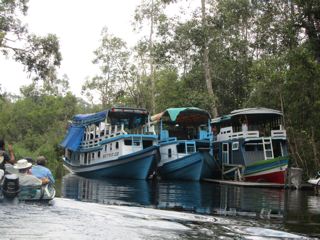 1 Klotoks on the river 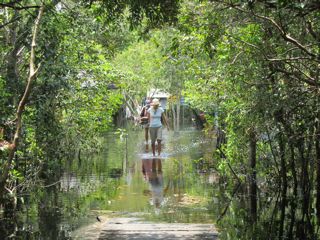 2 Flooded boardwalk 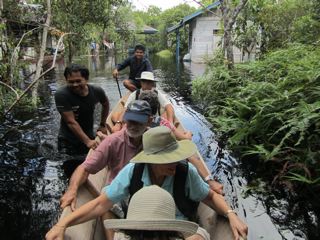 3 VERY unstable canoe! 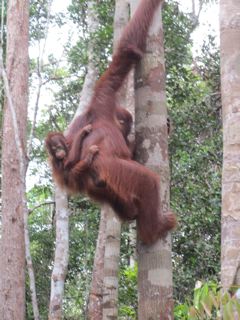 4 Our first orangutans 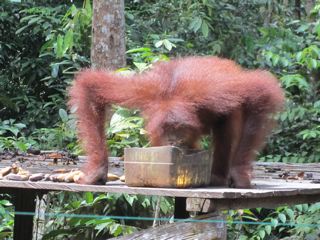 5 Mmm, milk 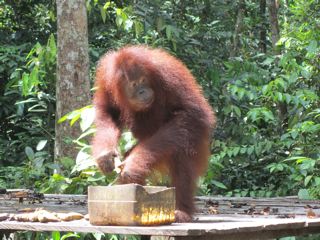 6 Milky chin 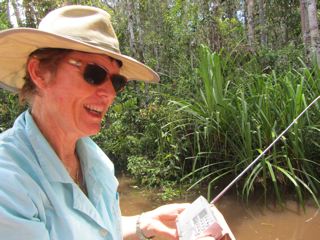 7 Listening to the AFL grand final! 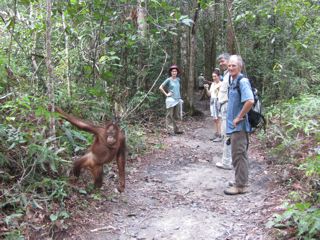 8 The people you meet 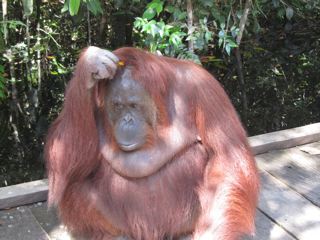 9 The 'queen' using a razor to comb her hair 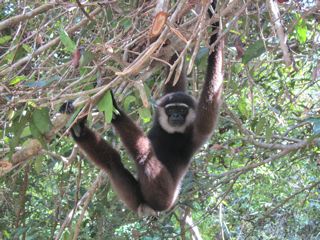 10 Gibbon 11 Tom, the dominant male |
